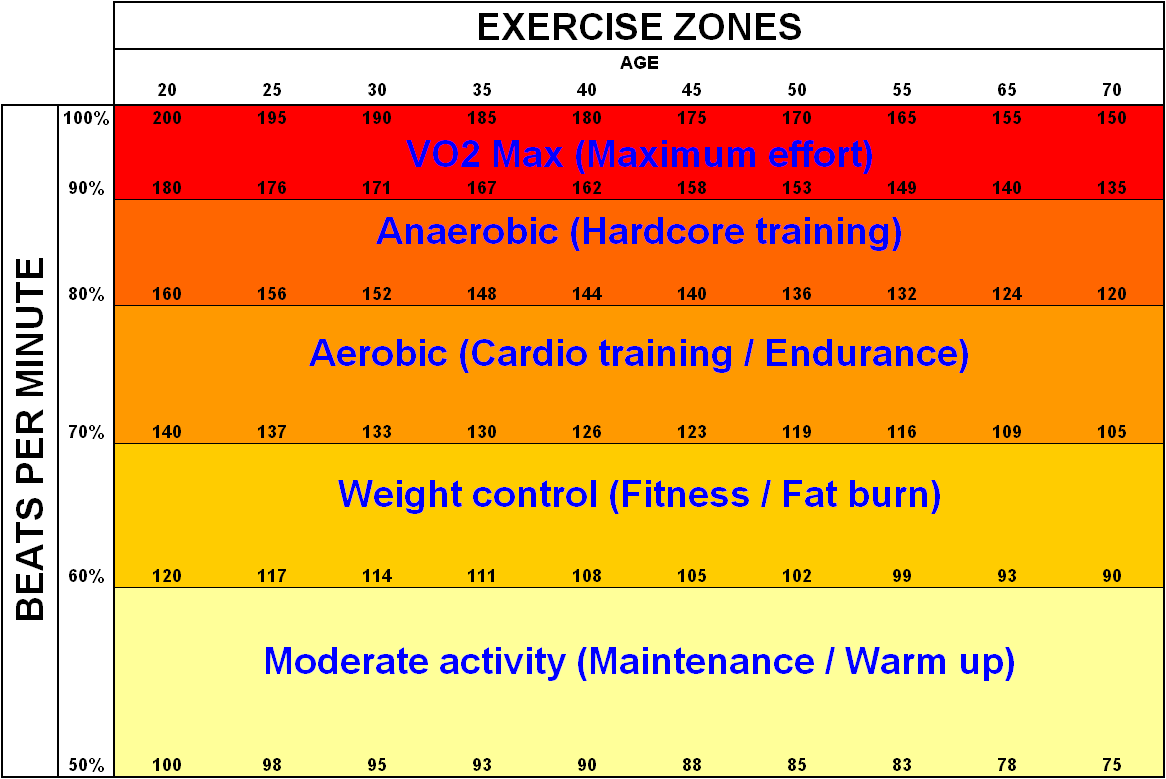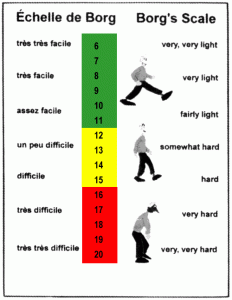People get out of shape and put on too much weight for fundamentally two reasons: they eat too much and they don’t move enough.
The solutions to these two problems are fundamentaly simple : eat less and exercise more. However, what people need to do depends on the relative percentages of these two main factors contributing to their lack of svelteness . Accordingly, their respective fitness solutions will differ. I’ve identified a few categories of challenged folks as examples of the need for different approaches. Before that, though, a couple of notes:
This is a good general summary of how much exercise adults may need.
Generally, you will read about two types of exercise: aerobic (essentially “cardio” training) and anaerobic (for our purposes, weight training). Here’s a primer if you’re not familiar. The numbers that go from left to right on the following chart refer to heart rate in beats per minute. The percentages refer to percent of maximum heart rate and use the standard estimate of 220 maximum beats per minute for essentially a new-born, minus your age. This rough calculation (in my case, 220 – 57 = 163) seems to be useful for about 80% of the population. However, about 20% of people fall well outside of these estimates.


If it turns out that your maximum heart rate is significantly lower or higher than the estimate, you will have to pay a little more attention and go by something like the Borg Rating of Physical Exertion.
1. The first group of fitness challenged folks is the (mostly) guys who move vigorously all day long in physically demanding jobs like construction. How on earth can a mason have a big ‘ol beer gut? You guessed it, from drinking too much beer! And too much fast food; and too much food, period. These guys just consume a staggering amount of calories. Their primary solution is obvious: they have to eat and drink less. I have a friend that used to own a small airplane. At 5’ 8″ he usually walked around at about 260 pounds. Every two years when he had to go in for his FAA third class medical exam, he would just quit drinking beer. He claimed that he could reliably lose 40 pounds in three months.
Exercise is helpful, but obviously not as critical for these guys. Certainly their heart and lungs would benefit from a good half hour of moderate to intense aerobic work 3-5 times per week. Lifting weights 2-3 times per week with a special emphasis on strengthening core and back muscles would be an efficient and productive use of their time.
2. The second group is those poor folks who already eat fairly healthy most of the time. They have been watching what they eat for what seems forever and still can’t lose any weight. Certainly, more women are in this category. For these people, big improvements have to come from the exercise component. If they are within 10 or 15 pounds of their desired weight and holding steady, even the lower end of the recommendations should result in good progress. Two to three sessions of muscle strengthening exercises and 150 minutes of moderate intensity (or 75 minutes of vigorous intensity) aerobic activity would be a good start. Cut out that morning doughnut, bagel, or 580 calorie Starbucks Venti White Chocolate Mocha and you will be off to a good start .
3. The third group is a hypothetical worst case where they have almost everything working against them: they are 20 or more pounds above their ideal weight; they have never “really been that athletic”; they have a sit-down, very sedentary job; and they may even have limitations do to medical issues or previous injury. Going on another fad diet and signing up only to pretend to go to the gym two or three times per week is not going to get it done. The vast majority of these folks are not going to figure it out on their own. They need to commit 90 minutes a day, a minimum of four or five days per week, to be in the presence of qualified people whose job it is to guide and motivate them to success.
